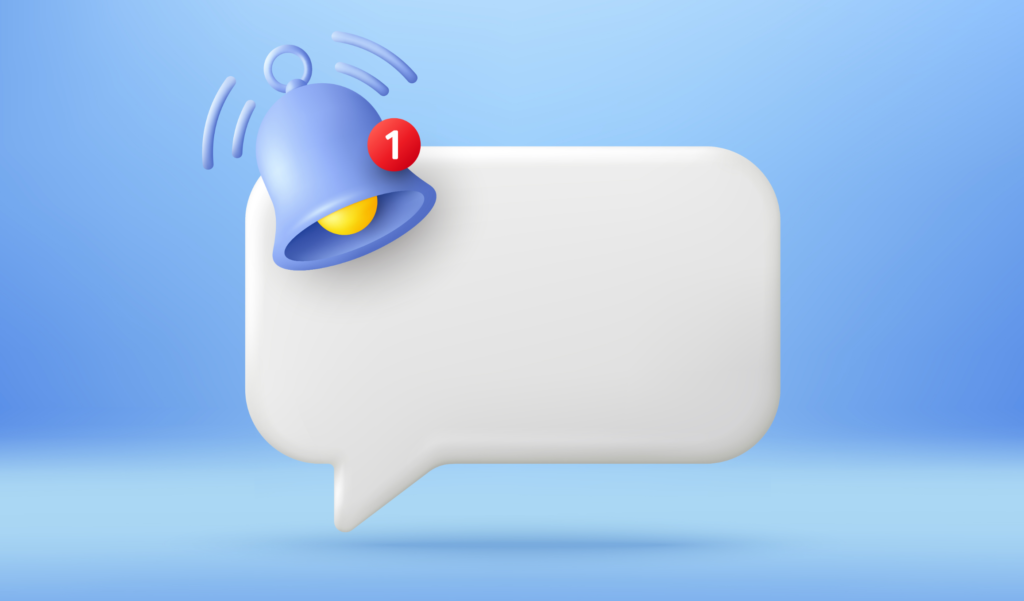“Attention is the most valuable currency today”, as modern marketers emphasize. But how to grab your users’ attention in a world of hundreds of daily distractions? That’s where push notifications come in. They are a direct line to your customers, but using them effectively is both an art and a science. Let’s explore how push notifications work, which push provider to choose in your app, what makes them so powerful, and how you can use them to build stronger, smarter connections with your customers. Read our Push Notifications How To Guide.
Push Notifications How To Guide: Small Messages, Big Impact
Push notifications don’t look like much. A few lines of text on a locked phone screen, maybe an image or action button. But when used well, they can drive real business results — re-engaging users, prompting purchases, delivering time-sensitive updates, and even shaping customer behavior.
For founders and product teams building a mobile app, they’re one of the most valuable tools in the toolbox. But to get real value out of them, you need more than just the ability to send them — you need to understand how they work in order to grasp their potential and design an effective strategy.
What Makes Push Notifications So Effective?
Push notifications are unique because they reach the user outside your app. You don’t have to wait for them to open it. You can initiate the interaction — directly, instantly, and (ideally) with relevance. This is why push messages outperform email and in-app messages in terms of open rates and engagement. They work best when they:
- Are desired by the user
- Are personalized (not just a mass blast)
- Are timely (aligned with user activity or intent)
- Respect boundaries (frequency, tone, relevance)
Push Notifications: How To Understand Tech Nuances
Here’s a quick breakdown of how push notifications travel from your back-end to a user’s screen.
The Technical Process:
- Step 1. Device Registration: When a user installs your app and opts in, the app requests permission to send notifications. If granted, the device receives a unique token* from the operating system (iOS or Android).
- Step 2. Message Sending: Based on the logic and message content you previously prepared, your backend system creates a notification and sends it, along with the device token, to a push notification service — Firebase Cloud Messaging (FCM) for Android and Apple Push Notification Service (APNs) for iOS (in the latter case, delivery occurs either directly or via FCM, depending on the application’s technology stack).
- Step 3. Routing & Delivery: The push service delivers the notification to the user’s device, where it pops up instantly.
*What is a “token” in push notifications?
A token is a unique ID that identifies a specific device and app install to the push notification system (Apple or Google). Think of it like a mailing address, but for a particular app on a particular phone.
So when your server (or service like Firebase) wants to send a notification, it needs to include that token in the message request — or it won’t know where to deliver it.
Important Note:
A token is tied to: One device and one app install. This means if the user reinstalls the app or switches phones, the token changes — so your system has to update it regularly.
A token doesn’t include personal info — it’s just a technical reference.
Local vs. Remote Notifications:
There are two types of push notifications:
- Local notifications are scheduled and triggered by the app itself (like a calendar reminder), requiring no internet connection.
- Remote (push) notifications are sent from your server via APNs or FCM, allowing for real-time, personalized, and automated messaging.

What’s a Push-notification provider and why do you need it?
A push notification provider is a service (or platform) that helps you send, manage, and track push notifications to your app users — across iOS, Android, or the web.
Can’t you just push notifications yourself?
Technically, you can’t send push notifications directly to someone’s phone from your app or server. That’s because only Apple (APNs) and Google (FCM) are allowed to send notifications to their platforms. These systems require your app to connect to their push services in a very specific way, with security keys, tokens, and complex delivery logic.
That’s where a push provider comes in. It acts like a middleman between your app and Apple/Google’s push infrastructure. It helps you with:
- Sending messages to the right devices (via Apple/Google)
- Managing user tokens, preferences, and segments
- Tracking delivery, open rates, and conversions
- Automating campaigns, like onboarding flows or re-engagement
- Handling retries, failures, and platform-specific quirks
Common Push Providers
Here are a few most popular push notification providers:
- Firebase Cloud Messaging (FCM) – free and built by Google, widely used for both Android and iOS devices.
Technical note: FCM doesn’t send directly to iPhones. Instead, it sends the push message to Apple Push Notification service (APNs) on your behalf. The advantage of using it is that it only needs a minor configuration to let it run automatically.
- OneSignal – developer-friendly, paid after exceeding a free tier, includes push + email + SMS and built-in analytics that offers more features at the start compared to the free Firebase version. Worth noting: OneSignal is designed for user engagement (like newsletters or promotions), not user authentication. It does not handle sign-up confirmation logic (email signup, password change etc.).
- Airship, Braze, CleverTap, Iterable – more advanced features for enterprise clients (especially for e-commerce or fintech). They can handle complex personalization logic, for example: A user who abandons a cart at 9:30 PM might, depending on their purchase history, location, device type, and engagement score, receive a personalized push at 10 PM, an SMS the next morning if they didn’t open it.
All push providers will need to connect to FCM and APN services, as these are the only gateways to your users’ devices.
While there’s no one-size-fits all solution, according to our experience, FCM or OneSignal will address 90% of your app’s needs unless you’re building an enterprise solution.
Firebase Cloud Messaging vs. OneSignal: Who wins?
If you’re deciding between Firebase Cloud Messaging (FCM) and OneSignal, the answer comes down to what you really need.
FCM is powerful, free, and tightly integrated with Google’s ecosystem — great for developers who are comfortable with custom implementation and want full control over the infrastructure. It offers basic UI and analytics out of the box. This means, as an app Owner, you’ll be able to use a FCM panel for creating push notifications campaigns, and check reports of deliverability. However, if necessary, you can add additional features and advanced analytics to the FCM panel as your app’s needs evolve.
OneSignal, on the other hand, shines in usability and feature depth: it supports push, email, and SMS in one platform, comes with a friendly dashboard, built-in segmentation, A/B testing, and automation tools — all without the need to write much backend code. For fast-moving startups, product teams, or marketers who want to test, iterate, and scale quickly, OneSignal often wins on productivity and time-to-value. But if you’re building highly custom systems, especially on Android or already using Firebase, FCM is a rock-solid foundation.
If email and text notifications are crucial to your app, you can either use:
- OneSignal if you want a turnkey system with faster time-to-market.
- Firebase + external services for email / SMS notifications
You can even combine both: use Firebase for in-app messaging and backend logic, and use OneSignal only for outbound push + email via API.
Can You Change Push Notifications Providers Later On?
Yes. If you expect your app will need a complex level of personalization and multi-channel presence for push notifications, you can switch to a different provider in the future.
Who Chooses the Push Provider?
This decision should be made together — between the product owner and the dev team.
As a founder or Product Owner, your job is to define:
- What kinds of notifications you’ll send (alerts, nudges, reminders, promotions)
- How often, and to whom
- What kind of targeting or automation you’ll need
- What insights or analytics you care about
- Expected app traffic
The dev team can then recommend the right tool, based on your needs and how much effort is needed to implement the specific push provider.
Not sure which push provider will fit your app’s needs best? We’ll help you choose and implement the right solution.
Let’s talk about your appFlutter vs. Native Coding: Does It Matter When Choosing a Push Provider?
The vast majority of push notification SDKs offer ready-made Flutter packages which means that pushes are fully supported no matter if your app is written in Dart (the language of Flutter) or separately in Swift (iOS) and Kotlin (Android).
When evaluating providers, it’s worth checking whether they include full Flutter support or if they require partial native implementation — which isn’t necessarily a blocker, but may add some complexity.
What About Push Notifications For Web and PWAs?
Push notifications are not limited to mobile apps only. They can also work in browsers (like Chrome, Firefox, Edge) and can be sent even when the website is not open, as long as the browser is running and the user gives permission.
Push Notifications and PWAs
This takes our Push Notifications How To Guide directly to PWAs (Progressive Web Apps). These are applications relying on web browsers which to the end user may look and feel like mobile apps. Moreover, modern PWAs can also be downloaded from app stores. While there are many advantages of developing a PWA instead of a mobile app, the use of push notifications is not one of them.
While mobile app pushes are delivered via Apple Push Notification service (APNs) or Firebase Cloud Messaging (FCM), pushes for PWAs work in the same way as web pushes. They are not connected to the device’s operating system, but rather its browser. This is why many device-specific functions will be limited or even impossible for push notifications on PWAs.
A few facts about pushes on PWAs:
- PWAs are web apps that behave like native apps when installed.
- Once installed, PWAs can use push notifications just like a mobile app.
- Push functionality depends on OS and browser: On Android, PWAs can send push reliably (but with limitations, which we discuss further below). On iOS, push is available only if the PWA is installed via Safari, added to the home screen manually, and permissions are granted.
When it comes to push notifications, mobile apps have the upper hand over PWAs in the following areas
- Silent Pushes
Mobile apps can receive data-only push notifications that don’t show anything to the user but can trigger background actions (e.g. sync data, check for new content).
PWAs can’t receive silent pushes — every push must show a visible notification.
- Offline & Local Notifications
Mobile apps can schedule local notifications — even without an internet connection. Example: “Time to take your 8pm. medicine” fires without needing a server call.
PWAs rely on remote pushes only.
- Deeper Device Integration
Native apps can trigger notifications based on:
- Bluetooth
- Location (geo-fencing)
- Motion sensors
- Battery state
PWAs don’t have access to most of these system-level features (especially on iOS).
- Better User Trust & Opt-in
PWAs often struggle with push permission prompts — users are conditioned to reject them in the browser.
In a mobile app, users are more likely to grant permissions during onboarding, with more context.
If push notifications are critical to your app’s user experience — especially for timely, personalized, or background communication (“It’s time to take your medicine”) — mobile apps offer far more reliability and capability than PWAs. You can still use pushes on PWAs for simple, lightweight use cases.
Types of push notifications: how to categorize them based on their functional purpose and desirability
1. Social Notifications
- Examples: you’ve got a new message, follower, like, mention
- User Expectation: ✅ Highly expected and desired
2. Transactional Notifications
- Examples: order shipped, payment received, password reset
- User Expectation: ✅ Expected and essential
3. Marketing / Promotional Notifications
- Examples: flash sale, new feature, special offer, abandoned cart reminder
- User Expectation: ⚠️ Often unwanted unless highly relevant. However, they are super-effective to generate direct revenue for your business
4. Reminder / Scheduled Notifications
- Examples: appointment, daily goal, workout time
- User Expectation: ✅ Usually expected and helpful (if user-configured)
5. Location-Based Notifications
- Examples: “You’re near our store — 10% off”
- User Expectation: ⚠️ Mixed — can be useful or intrusive
6. System / App Status Notifications
- Examples: sync complete, offline mode, update available
- User Expectation: ✅ Expected in context
Best Practices for Effective Mobile Push Notification Campaigns
- Personalization: Use names, preferences, and behaviors to make messages relevant.
- Timing & Frequency: Use analytics to send notifications at optimal times and avoid over-notifying.
- Segmentation: Target groups based on activity, interests, or demographics.
- Rich Media: Include images, emojis, or interactive buttons for higher engagement (supported on both iOS and Android).
- Clear, Actionable Messaging: Keep it concise with a clear call-to-action.
- Respect Preferences: Make it easy for users to opt in, opt out, or customize notification settings.
Final Thoughts
Push notifications are a direct, powerful way to engage users—when used thoughtfully. By understanding the technical details, respecting user preferences, and focusing on relevance and timing, businesses can turn simple notifications into meaningful conversations that drive retention, loyalty, and growth. Ready to make every buzz count? The right strategy can put your app—and your brand—front and center, right in your users’ hands.







